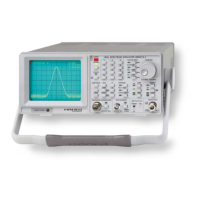19
Subject to change without notice
3. Adjustment
level from –20 dBm to –60 dBm. Errors can occur in absolute
position or in scaling.
While performing this measurement, do not vary
the ATT setting.
Adjustment is best done setting the HM 8134-3 to a step of 20
dB, and varying the amplitude fom –20 dBm to –40 and –60
dBm, observing the marker level displayed on the CRT. Use P8
(see Fig. 3-5) to set the steps to 20 dB each, and P9 to set the
absolute position. When done, check in 10 dB-increments and
repeat the adjustment procedure if necessary.
3.2.7 Adjustment of RBW fi lters
The RBW fi lters of the HM5014-2 are not to be adjusted by ser-
vice personnel. This process is very complicated and delicate
and the chances of positive outcome are very slim. If the fi lters
have become defective, the only remedy is to change the IF Unit
against a working unit. This is described in chapter 5.
3.2.8 Adjustment of 5 dB/Div
In order to check the 5 dB/Div adjustment, use measurement
setup I and set the HM 8134-3 to the following:
Frequency 500 MHz
Amplitude -30 dBm
Output On
Modulation Off
Sweep Off
Select item „5dBADJ“ in the internal adjustment menu as
described in section 3.2.1. The “OSCCAL”-text will change to
“S10MHz”. Now switch through the ATT settings from 0 dB
to 40 dB and observe the location of the center of the trace
on the CRT. No marker function is available for this test. The
trace must change 2 graticule divisions for each attenuator
step, and the value for the 10 dB attenuator step may be in the
range of 1,6 to 2,4 graticule divisions from the top of the CRT
graticule grid.
For adjustment of the 5 dB/Div setting, set the distance on CRT
exactly to 2 cm from the top of the graticule using the rotary
encoder. Switch off the unit to leave the adjustment menu.
3.2.9 Adjustment of test signal level
To check the test signal level, it is very important that a cor-
rect warmup of the instrument has taken place and that the
instrument is operated at the ambient temperature indicated
in the specifi cations of the HM5014-2.
Set the HM5014-2 to the following:
Center 48 MHz
Span Zero span
RBW 1 MHz
ATT 10 dB
Marker active
Test signal active
(Max Hold, Average, Video fi lter and Tracking Generator not
activated)
Connect coaxial cable [M8] using [M11] to the test signal output
and to the RF input of the HM5014-2. The marker reading may
be in the range of –27.0 dBm to –33.0 dBm.
Adjustment of the test signal level is done by connecting the test
signal to the RF input of the HM5014-2, adjusting the marker
readout exactly to –30 dBm. The Potentiometer P10 under the
shield of the DDS part of the CPU-board is used to set the test
signal to the level of –30 dBm (see Fig. 3-5).
3.2.10 Adjustment of TG amplitude
To check the adjustment of TG amplitude, set the HM5014-2
to the following:
Center 500 MHz
RBW 1 MHz
Span Zero Span
ATT 40 dB
Ref.-Level +10 dBm
Marker Active
TG Active
TG Level +1 dBm
(Max Hold, Average and Video fi lter not activated)
Observe the marker level displayed on the CRT, and compare
the displayed level to the level shown on the readout. Vary the
level from +1 dBm to –10 dBm and check the marker readout
vs. the TG level readout.
Now set the ATT to, 30, 20, 10 and 0 dB while setting the TG level
from –10, -20, -30 and –40 dBm to minimum, so that the reading
of the marker value stays in the same major graticule division
on the CRT for best precision of the marker values.
The difference between readout of TG level and readout of mar-
ker level may not exceed 3 dB in either direction.
Adjustment of the TG level is accomplished using the internal
adjustment menu (see 2.2.1). Use a coaxial cable [M5] to con-
nect the TG output to the RF input. Activate the item “TGL +1”
and adjust the trace in centre of the screen to 1 mm above the
second graticule line from the top, ATT of the receiver must be
set to 40 dB (ref.-level of +10 dBm). Adjust the level using the
rotary encoder. Then choose the menu item “TGL-10”, set the
ATT of the receiver to 30 dB, and place the trace in the centre of
the screen exactly on top of the second graticule line from the
top. Using the same position on the CRT assures no extra errors
introduced by the signal processing path of the HM5014-2.
After completing the adjustment, leave the menu by switching
off the HM5014-2. Then check the level adjustment as descri-
bed in para. 2.2.10.
3.2.11 Full band amplitude check
There is no adjustment possible in case the full band amplitude
check in 2.2.11 is not passed. Refer to chapter 4 for trouble-
shooting and chapter 5 for repair of the unit.

